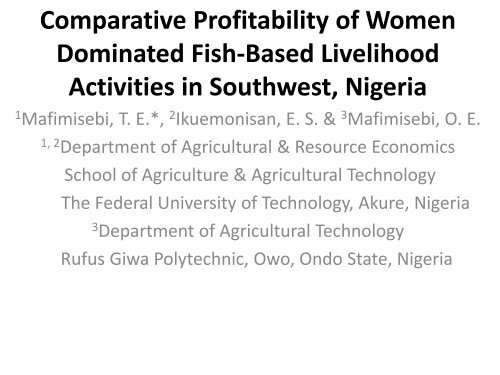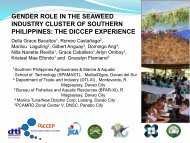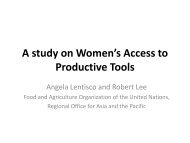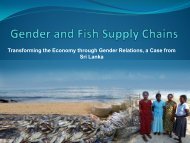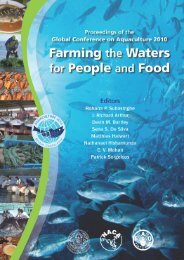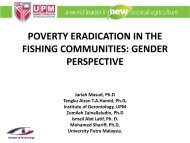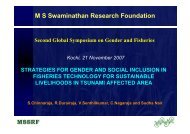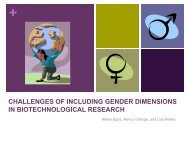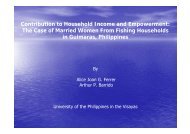Taiwo Mafimisebi
Taiwo Mafimisebi
Taiwo Mafimisebi
- No tags were found...
You also want an ePaper? Increase the reach of your titles
YUMPU automatically turns print PDFs into web optimized ePapers that Google loves.
Comparative Profitability of WomenDominated Fish-Based LivelihoodActivities in Southwest, Nigeria1<strong>Mafimisebi</strong>, T. E.*, 2 Ikuemonisan, E. S. & 3 <strong>Mafimisebi</strong>, O. E.1, 2Department of Agricultural & Resource EconomicsSchool of Agriculture & Agricultural TechnologyThe Federal University of Technology, Akure, Nigeria3Department of Agricultural TechnologyRufus Giwa Polytechnic, Owo, Ondo State, Nigeria
INTRODUCTIONWomen are more disadvantaged than men in securingformal sector employment opportunitiesLess access to resources and skills tend to confine themlow-investment and low-income informal sector livelihoodactivitiesIncreasing economic and social pressures on women tocontribute more to household income and assetsThis has challenged them to widen or broaden their onfarmand off-farm agricultural activities in a bid to improvelivelihoodThe capacity of smallholder farming and artisanal fishingto provide the major means of survival for the ruralpopulace is fast diminishing in the developing world
INTRODUCTION Women are a great force behind the diversification of incomefetchingactivities They do all sorts of things to assure the household of foodsecurity during off-farm seasons and periods of shocks Two informal sector livelihood activities in which womenpredominate in Nigeria are artisanal fish capture andmarketing of fresh fish Nigeria is blessed with over 14 million hectares of reservoirs,lake, ponds and major rivers capable of producing over980,000 metric tonnes of fish annually (FDF, 2007)
THESIS For women, fishing, fish processing and sale provide a very importantlivelihood support. In coastal communities, women dominate theprocessing and local trade in fish Most of these women lack education, literacy and the financial capitalto engage in other livelihood activities Some women who depend on fish-based livelihood strategies asprimary or only source of income are heads of households (Hall, 2005;Fasina and <strong>Mafimisebi</strong>, 2010) Thus, fish based livelihoods hold great potential for income generationand poverty reduction especially among communities or householdsliving near water resources (Onoja et al., 2012) Any attempt to improve women’s economic status requires informationon returns to investment in their traditional livelihood activities
METHODOLOGYThe study utilized primary data collected from 55fisher folks and 80 fish marketers selectedthrough multi-stage sampling methodData collected were summarized usingdescriptive and inferential statistics and analysiswas done using budgeting and regression modelsZ-statistic was used to test significance ofselected variables while regression model helpedto identify factors influencing returns to thelivelihood strategies
ANALYTICAL TECHNIQUESNP= TR-TC---------------------------------- 1Where NP= Net ProfitTR = Total RevenueTC = Total CostzX − 1X −2=S21−Xn1 22S21−+−Xn2Where z = standard “Z” distribution value (Z calculated)= mean net profit for fisher folks= mean net profit for fish marketersS 1 = standard deviation of net profit sample mean for fisherfolksS 2 = standard deviation of net profit sample mean for fishmarketersn 1 = sample size for fisher folks (55)n 2 = sample size for marketers (80)
For fisher folks,Y = f (X 1, X 2, X 3, X 4, X 5, X 6, X 7, X 8, u) ……………………(3)WhereY = Profit from fishing (N)X 1= Quantity of fish caught for sale (kg)X 2= Cost of input (N)X 3= Age (years)X 4= Fishing ground (freshwater =1 saltwater = 0)X 5= Distance covered (nautical miles)X 6= Household sizeX 7= Years of experience in huntingX 8= Season (raining season =1 dry season = 2)u = Random component which takes care of omitted variablesthat could affect profit
For fish marketers, the explicit regression equation is of theformY = f (X 1, X 2, X 3, X 4, X 5, X 6, X 7, X 8, u)……………………………(4)WhereY = Profit from fish marketing (N)X 1= Quantity of fish sold (kg)X 2= Cost of transportation (N)X 3= Cost of fish purchased for resale (N)X 4= Cost of other marketing functions (N)X 5= Household sizeX 6= Years of marketing experienceX 7= Age (yrs)X 8=Number of years of formal educationu = Random component which takes care of omitted variablesthat could affect profit
RESULTS AND DISCUSSION Empirical findings revealed that about 75.0% of fisher folkseither had no formal education or had only primary education Majority (50.0%) of marketers had secondary school education About 74.0% of fisher folks and 66.0% of marketers consideredtheir venture as major livelihood source Most (77.6%) of respondents took to these ventures to providefor their households or supplement spouse’s income
Table 1: Distribution of respondents by Selected Socio-economicCharacteristicsVariables Fisher Folks FishMarketersLevel of Formal Education Numb % Number %AttainederNo Formal Education 17 30.5 20 24.8Primary School Education 24` 44.5 20 25.5Secondary School Education 14 25.0 39 49.7Tertiary Education 0 0.0 0 0.0Total 55 100 80 100Class of OccupationMajor 41 74.5 70 56.0Minor 14 25.5 10 44.0Total 55 100 80 100Source: Survey data, 2012.
Table 1: Distribution of respondents by Selected Socio-economicCharacteristicsVariables Fisher Folks Fish MarketersMarital Status Number % Number %Married 41 74.6 80 100Widow 5 9.1 0 0Divorced 4 7.3 0 0Total 55 100 80 100Household Size≤ 6 28 50.9 46 57.57 – 13 22 40.0 25 31.3>14 5 9.1 09 11.2Total 55 100 80 100Source: Survey data, 2012.
Table 1: Distribution of respondents by Selected Socio-economicCharacteristicsVariables Fisher Folks Fish MarketersMarital Status Number % Number %Age Distribution(yrs)< 35 21 38.0 19 23.736 – 40 17 30.8 23 28.741 – 45 14 26.2 17 21.3> 50 3 5.0 21 26.3Total 55 100 80 100Mean 38 41Years of Experience1 – 5 7 12.7 15 18.66 – 10 41 74.3 56 70.011-15 7 13.0 9 11.3Total 55 100 80 100Source: Survey data, 2012.
Cost Components and Profitability of Operations The budgeting model revealed that fisher folks incurred annualtotal variable cost of N 1,158,174.00, total fixed cost ofN 4,757,151.25 while total revenue was N 8,297,952.00 The corresponding value for marketers was N 1,202,606.00,N 385,167.00 and N 2,228,000.00 The net revenue accrued to fish hunters per annum wasN2,882,626.00 while that of marketers was N 640,227.00 At 53.2% for fish capture and 40.3% for fish marketing, returns toinvestment was better in fish capture than in fish marketing There were significant differences between profit realized fromthe two livelihood sources at conventional significance levels
TABLE 2: Cost Structure of Fisher folksCost (N) Percentage (%)A) Revenue generated from fishhunting per year = N8, 297,952.00B) Variable CostsTraps and baits 846,174.00 12.24Other materials 312,000 4.51Total Variable Cost (TVC) 1,158,174.00Source: Survey data, 2012.
TABLE 2: Cost Structure of Fisher folks(Contd)Cost (N)Percentage (%)C) Depreciated fixed cost ItemsBoats/Canoes 5,757,151.25 83.25Total Fixed Cost (TFC) 5,757,151.25Total Cost (TC) 6,915,325.25Source: Survey data, 2012
Table 3: Cost Structure of Fish MarketersCost (N) Percentage (%)A) Revenue generated from fish huntingper year = N2, 228,000B) Variable CostCost of Transportation 126,024.00 7.93Labour 23,744.00 1.50Cost of Fish sold 1,052,838.00 66.31Total Variable Cost (TVC) 1,202, 606.00Source: Survey data, 2012.
Table 3: Cost Structure of Fish Marketers (Contd)Cost (N)Percentage(%)C) Depreciated fixed cost itemsRent of Premises(including market180,000.00stall)11.34Basket 15,523.40 0.98Boats/Canoes 140,300.00 8.86Other Marketing functions 49,343.60 3.10Total Fixed Cost (TFC) 385,167.00Total Cost (TC) 1,587,773.00Source: Survey data, 2012.
NET REVENUEFor Fisher Folks:Net Revenue (NR) = Total Revenue (TR) – Total Cost (TC)NR = N8, 297,952.00 - N 6,915,325.25NR = N2,882,626.75For Fish Marketers:Net Revenue = Total Revenue (TR) – Total cost (TC)NR = N2,228,000.00 - N1,587,773NR = N640,227.00These returns are comparable to returns from otherinformal sector ventures in Nigeria (<strong>Mafimisebi</strong> et al.,2002; <strong>Mafimisebi</strong> and Okunmadewa, 2004; <strong>Mafimisebi</strong>,2007; <strong>Mafimisebi</strong> et al., 2013)
Test of SignificanceUsing the Z-statistic to test for significant differencebetween the returns from the two ventures gave resultshowing that there was a significant difference betweenthe income generated by fisher folks and fish marketersat the 1% significance levelGroup Number (N) MeanIncome(N)Fisher Folks 55 57,652.54Fish Marketers 80 8,002.84Source: Survey data, 2012Z-Calculated33.7***
Factors Influencing Income from Fish Huntingand Fish Marketing The factors influencing profit generated from fish hunting andmarketing were determined through multiple regressionmodel In both cases, the double-log functional form gave the best-fitequation For fish hunting, the coefficient of determination, R 2 values of0.76 indicated that 76.0% of the variations in income wereexplained by the explanatory variables.
Factors Influencing Income from Fish Huntingand Fish MarketingOLS regression result showed that the significantfactors which influenced returns from fish captureincluded quantity of fish caught, experience, seasonand distance covered in fishingQuantity of fish sold, transportation cost, purchasecost, experience and household size were thesignificant factors influencing returns from fishmarketing
Table 5: The regression results of the determinants ofreturns from fish huntingVariable Coefficient Beta T SignificanceConstant 9.282 - 6.235 0.000***Qty of fish caught 0.601 1.421 3.421 0.001Cost of input -0.831 -0 .174 -1.264 -0.674Age 0.261 2.163 1.382 0.592Fish ground 0.127 0 .116 0.751 0.041**Distance Covered 0.506 0.374 3.780 0.057**Household size 0.341 0.206 2.783 1.795Years of Experience 0.591 0.276 2.731 0.041***Season 0.228 0.103 5.232 0.002***Source: Survey data, 2012
Table 6: Results of Regression Determinants of Returnsfrom Fish MarketingVariable Coefficient Beta T SignificanceConstant 6.732 - 3.882 0.000*Qty of fish sold 0.201 0.204 2.534 0.032*Cost of Transportation -0.263 -0 .174 -1.134 -0.049**Cost of fish purchased for resale -0.276 -0.263 -2.331 -0.005***Cost of other marketing functions -0.027 -0 .056 -0.425 -0.534Household size 0.006 0.248 2.080 0.035**Years of marketing experience 0.141 0.163 1.783 0.009***Age 0.392 0.316 3.33 0.142Level of Education 7.328 0.421 4.182 1.529Source: Survey data, 2012
Coefficients of Determination and Significant LevelFor Fish Hunting: R 2 = 0.76 Number of significant variables = 4For Fish Marketing: R 2 = 0.72 Number of significant variables = 5• ***1% significant• **5%significant
Contribution of Fisher Folks’ and Fish Sellers’ Incometo Household Expenditure‣ The primary objective of the respondents’ engagement in fishhunting and marketing is to earn income to sustain theirlivelihood‣ Thus, respondents used part of their profit to supplementhousehold expenditure and ploughed the remaining back intotheir business‣ Table 7 showed the average contributions made by respondentsto supplement household expenditure‣ The fisher folks spent 77.8% of the returns on their fish huntinginvestment to supplement household expenditure andploughed back 22.2% into the venture
Table 7: Share of Respondents’ Earnings Devoted toHousehold ExpenditureCategory of Contribution Share of Plough ShareRespondents to Household the back to of theExpenditure(N)Profit(%)Business(N)profit(%)Fisher folks 2,242,683.61 77.8 639,943.14 22.2Fish marketers 443,037.08 69.2 197,189.92 30.8Source: Survey data, 2012
CHALLENGES FACED IN LIVELIHOOD ACTIVITIES The major challenges faced by fish hunters includedincreasing cost of canoes, short supply of gears, attack onfishing gears and fisher folks by dangerous animals andpoaching of fish traps For marketers, challenges included high transportation costand losses from perished unsold fish Both groups face lack of access to formal credit Organizing women informal sector operators into groups toenable them access government support and bank creditare recommended for improving women’s livelihood It is concluded that fish capture and fish marketing areprofitable ventures and that earnings realized contribute tohouseholds’ welfare
RECOMMENDATIONS AND CONCLUSION The study concluded that fish capture and fish marketing wereprofitable ventures and that income realized made contributions touplifting households’ living standards Policy makers are enjoined to make policy to assist group formationby women in informal sector ventures to empower them and enablethem access bank credit and capital assets Capacity building programmes directed at better businessmanagement are also necessary Policy on sustainable fishing and better preservation facilities toenhance returns are important issues in improving businessperformance in these women-dominated ventures
THANK YOU FOR YOURATTENTION


